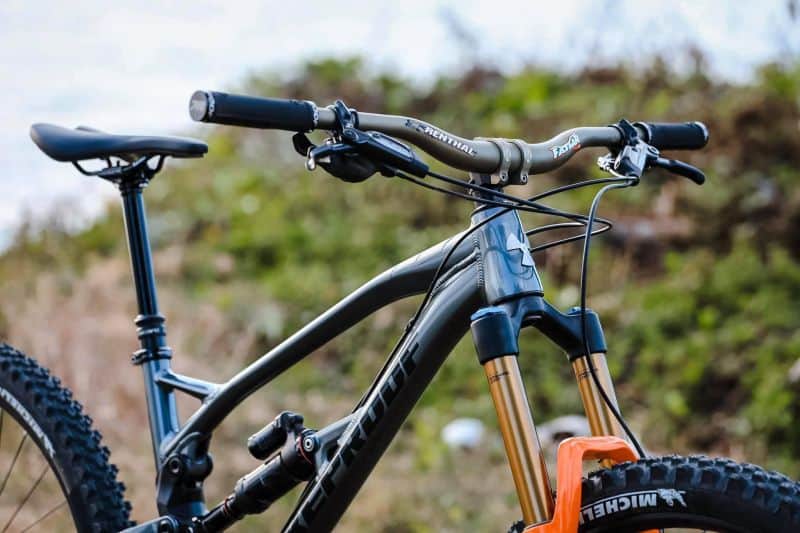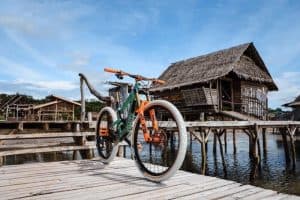Last Updated on December 5, 2022

Mountain biking is not all about riding your bike and heading to the trails. You also need to know the bike you’re riding.
One good way of doing this is to know the parts of a mountain bike. This lets you enjoy the outdoors more because you know what you’re riding. You can adjust the parts to your own preference and size. You’ll also know how to repair your bike if something breaks or gets loose.
Mountain bikes are made of multiple parts. And each plays an important role in your riding. It just makes sense to know what these parts are, what they do, and how they can affect your ride.
That’s just what we’ll talk about here because we’ll show you all the parts of a mountain bike. We’ll also explain what they are, their function, and the different variations out there.
This lets you know your bike more so you’ll have a better time out in the trails.
Frame
The frame is also called the body of your bike. It is where all the parts are connected to. Your bike won’t be in shape without it.
Mountain bike frames are usually made from aluminum alloy and the more expensive carbon. There are also hardtail frames and full-suspension frames. Hardtails have no shock and linkages compared to the full-sus ones.
Related: How to Measure a Mountain Bike Frame
Suspension
Fork
The fork is at the front-most part of your bike. This is connected to your frame’s head tube and your front wheel.
It absorbs and soaks up the bumps you’ll encounter in the trail. This makes your ride more comfortable. It also lets you traverse gnarly trails impossible to pass through without a fork suspension. The best forks comes from Fox Shox and RockShox.
Shock
The shock is only present on full-suspension frames. They are also usually found on downhill, enduro, and trail bikes. They are attached to your frame and absorbs the bumps you get at the rear via the moving linkages. Fox Shox and RockShox are also the top brands that manufacture shocks.
Cockpit

Handlebar
The handlebar gives you direct control over your bike. It lets you maneuver and turn because it’s connected to your fork, which is also attached to your front wheel. Downhill and enduro handlebars have a low-rise shape and measure 750 mm to 800 mm. Meanwhile, cross-country handlebars have a straighter shape and measure around 700 mm to 730 mm.
Stem
The stem connects your handlebar to your frame. It’s attached on the center-most area of your handlebar. Short stems are designed for downhill and enduro riding. While longer negative stems are for cross-country cycling. They usually have a 30 mm to 35 mm clamping size.
Grips
The grips is the only part of your mountain bike that you directly hold. This is why it’s very important for you to have a grippy and comfortable grip. Nukeproof, RaceFace, and Ergon are among the top brands that make the best grips.
Related: What Are the Best Mountain Bike Grips to Buy
Saddle
This is where you sit when riding your bike. They come in different shapes and sizes, but they all have a similar v-shaped design that contours to your riding position. This is connected directly to your seat post.
Seat post
The seat post is what supports the saddle where you’re sitting on when riding. Its lower section is also connected to your frame. Almost all seatposts now have been upgraded to dropper posts.
These are seat posts that can go up and down with a gentle press of the lever. They come in handy when approaching technical sections where you need to lower your body down to gain balance.
Pedals
The pedals are the platform that makes your bike move. It’s connected to your cranks. They come in two types which are flat pedals and clipless pedals. Flat pedals have pins that secure grip on your shoes.
Meanwhile, you need to have clipless shoes if you’ve got clipless pedals. This locks your feet to the pedal. But you can easily remove it by sliding your foot outwards.
Related:
What Are the Best Mountain Bike Pedals Out There
8 Best Mountain Bike Shoes for Flat Pedals
Drivetrain
Shifters
The shifters come in the form of levers which you push, using your thumb to shift your cog’s gear. Shifting it upward brings the chain to the bigger cogs which makes pedaling softer. Shifting it downwards does the other way and brings your chain to the smaller cogs.
Cogs
The cogs are the round gears found on the right and back-most portion of your bike. This is connected to your hubs, which makes your bike move. The latest cogs today have 12 rings which are called 12-speed. The smallest cog has 11 teeth while the largest has 50 to 52 teeth.
Chainring
This works in tandem with your cogs and is found on its front just right beside your pedals. This is connected to the chain which transfers your pedaling energy to the cogs. Enduro chainrings have around 30 to 32 teeth.
Cranks
The cranks are where your pedals are attached to. They come in aluminum alloy and carbon, with the latter being the more expensive one. Their measurement is around 165 mm to 175 mm. 165 mm cranks are for downhill, 170 mm are for enduro, while 175 mm cranks are for cross-country.
Chain
The chain converts your pedaling energy to your bike’s motion. They come in different colors like black, silver, and gold.
Brakeset
Lever
This is what you pull using your pointer fingers to slow down your bike or make it stop. They’re attached to your handlebar, with one on each side.
Brakes and Rotors
The levers are then connected to the brakes and rotors via a hose where brake fluid runs through. Your brake’s pistons clip into your rotors. This then slows it down and makes it stop. The harder you pull the lever, the stronger braking power is generated
Wheelset
Rims
The rims give support to your tires. It’s the base where your tires are wrapped around. They’re usually made from aluminum. But there are also more expensive carbon rims around. They measure 25 mm to 38 mm in width. They also come in 26, 27.5, and 29-inch diameters.
Tires
The tires are the only part that comes in contact with the ground. They also come in 26, 27.5, and 29-inch sizes, with the two latter choices being the most popular.
Here are 3 of the top tire brands most mountain bikers use:
Related: The Best Road Tires for Mountain Bike
Hubs
The hubs connect your drivetrain to your wheels. They make your bike move with the help of the spokes attached to your rims. Remember to choose a hub with fast engagement so you can have a more efficient pedaling.
Conclusion
Knowing the parts of a mountain bike is important for every mountain biker. Not only does this make them prepared for whatever happens on their ride. But this also lets them choose the right parts and adjust it based on their size and preferences.
Take note that a mountain bike comprises multiple parts. Even more than the ones mentioned in this article. Do your best to maintain them and keep them in proper shape for you to maximize your biking experience.
